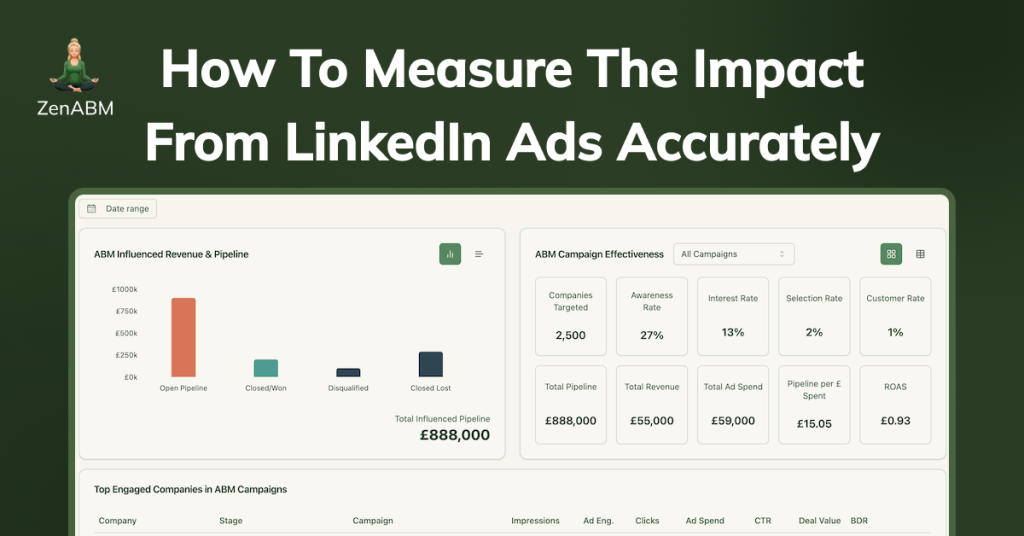LinkedIn, as they rightly say, is not a search-based platform but more like a billboard when it comes to ads.
So, to truly measure the impact of your LinkedIn ad campaigns (i.e. the pipeline influence and ROI of each LinkedIn ad), you need to look past clicks, form-fills, etc., and focus on company-level engagement tracking (to the level of impressions and not just clicks) for each campaign.
But, as I’ll show you in the article, most conventional methods marketers use fail at providing accurate view-through attribution, so they fail at measuring the true impact of each LinkedIn ad.
Let me tell you more…
Why Conventional Methods Can’t Deduce the True Impact of LinkedIn Ads?
For starters, LinkedIn functions more as a brand awareness channel than a direct response platform. Compared to search ads, LinkedIn ads tend to generate far fewer clicks. Just take a look at its average CTR:
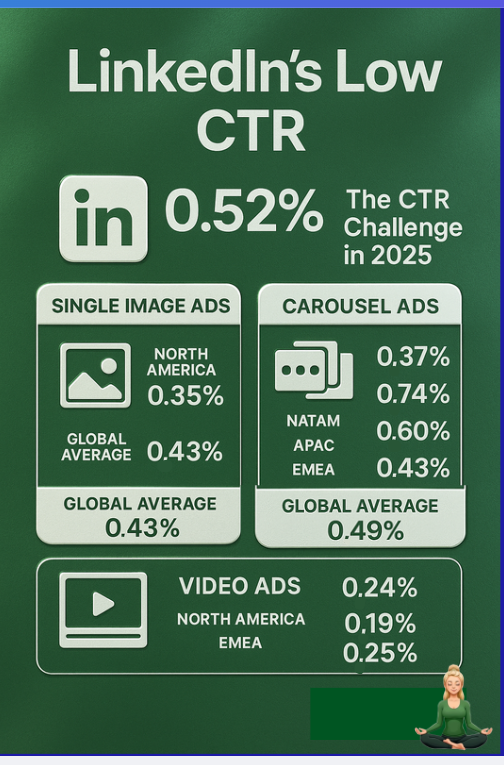
Unlike someone using Google Search with a clear intent to find and click, LinkedIn users are typically browsing their feed passively. Your target decision-makers may view your ad but end up Googling your brand or heading straight to your site later on. That interaction often gets chalked up to organic or direct traffic, masking LinkedIn’s actual role in driving interest.
Solution?
You need more than click metrics to understand impact. Measuring LinkedIn ad effectiveness means accounting for view-through influence—tracking who saw and engaged with your ad, even if they didn’t click.
While many B2B teams recognize this need in theory, implementing it is tough. Most standard analytics tools simply aren’t built to deliver this level of insight:
LinkedIn Campaign Manager
LinkedIn’s native Campaign Manager has long offered limited visibility at the company level. Back in late 2020, they rolled out the “Company Engagement Report,” which was later rebranded in 2024 as the “Companies” tab:

This tab gives a broad overview of how companies interact with your ads, including metrics like impressions and paid clicks, but it doesn’t connect that engagement to specific campaigns or individual ads. Everything is aggregated across your entire ad account.
Given that most marketers now run several ABM campaigns simultaneously, each with multiple ad groups and creatives, this is a major limitation. Without company-level data tied to each campaign or ad, you can’t understand which messages resonated, assess buyer readiness, or assign revenue influence correctly. And without this granularity, you’re left guessing about the real impact of your LinkedIn ads, unable to pinpoint top performers or conduct meaningful A/B tests.
Website Deanonymization Tools
What about using external tools that claim to uncover which companies are visiting your website? These platforms typically rely on IP address matching to associate site visits with company names. But here’s the catch: they only capture users who actually clicked on your ad and landed on your site. If someone simply viewed your LinkedIn ad without clicking, they’ll remain invisible, leaving a massive gap in your measurement strategy.
Even for those who do click, the data quality is often underwhelming. As shown in a Syft study, these tools average only around 40% accuracy. Why? Because IP identification is inherently flawed. It breaks down with VPN usage, shared networks like cafes or coworking spaces, and especially when companies haven’t registered static IPs:

Take this real-world case: Userpilot used Clearbit to analyze visitors from their LinkedIn ads. The tool managed to identify just one company — their own:
In short, traditional IP-based deanonymization tools offer very limited value when you’re trying to truly measure the impact of LinkedIn ads.
Display Ad Networks & Behavioral Data Matching
Some marketers experiment with display ad platforms like AdRoll or Criteo, hoping to gauge LinkedIn ad engagement by retargeting site visitors. These tools depend on cookies and device-level identifiers to estimate a user’s interests or associate them with a company. But this method has several flaws:
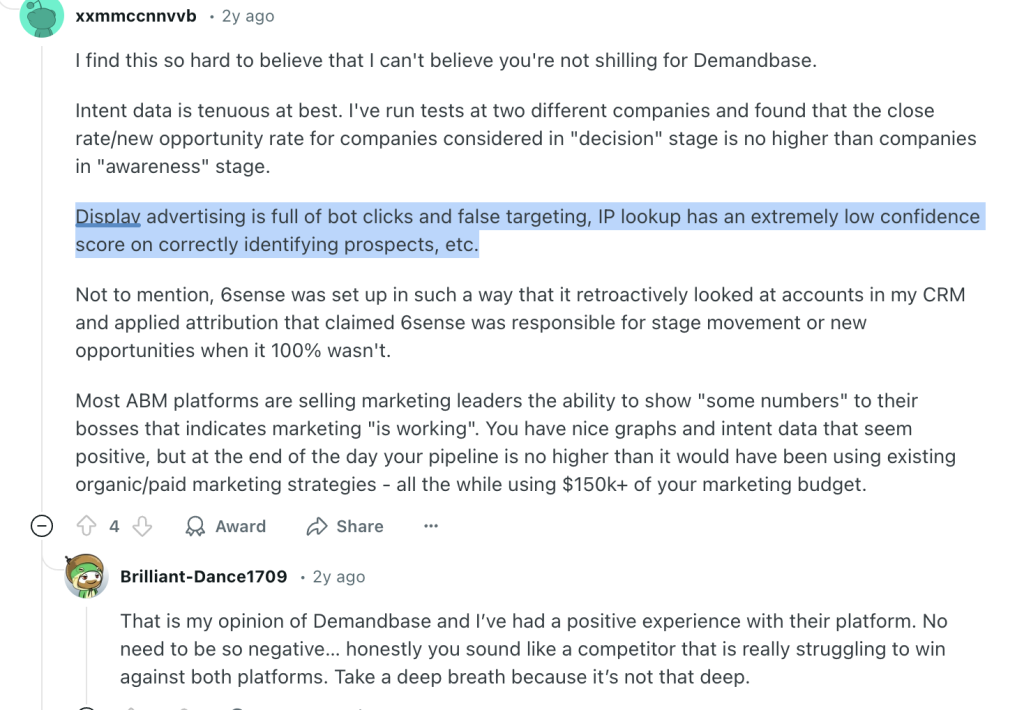
- Third-party cookies are on the way out: With Chrome phasing them out, any measurement method that leans on cookie tracking is quickly becoming obsolete.
- Outdated behavioral data: These systems may operate on old intel. If someone has recently switched companies, the tracking platform might still associate them with their former employer.
- Bot traffic distortions: Fake clicks and impressions are rampant in display ad ecosystems. This means a large chunk of your perceived LinkedIn ad “engagement” could actually be worthless noise.
LinkedIn Ads CRM Integration
Plenty of marketers try integrating LinkedIn Ads directly into their CRM — tools like HubSpot’s native integration make this easy. You can sync lead forms, run campaigns from inside the CRM, and centralize basic data. But when it comes to truly assessing impact, the approach leaves a lot to be desired:
- It tracks conversions at the individual level, not the companies that viewed or interacted with your ads.
- It can’t identify accounts that clicked but converted later, or during a separate session.
- It lacks visibility into which key accounts are consistently interacting with your ads over time.
- It doesn’t map ad engagement to pipeline progress or open deals within your CRM.
HubSpot’s tracking and LinkedIn’s Insight Tag both depend on cookies or form submissions to attribute engagement. If someone fills out a demo request without listing their company, or clicks on the ad but submits the form much later or via another device, the system may fail to connect those dots:
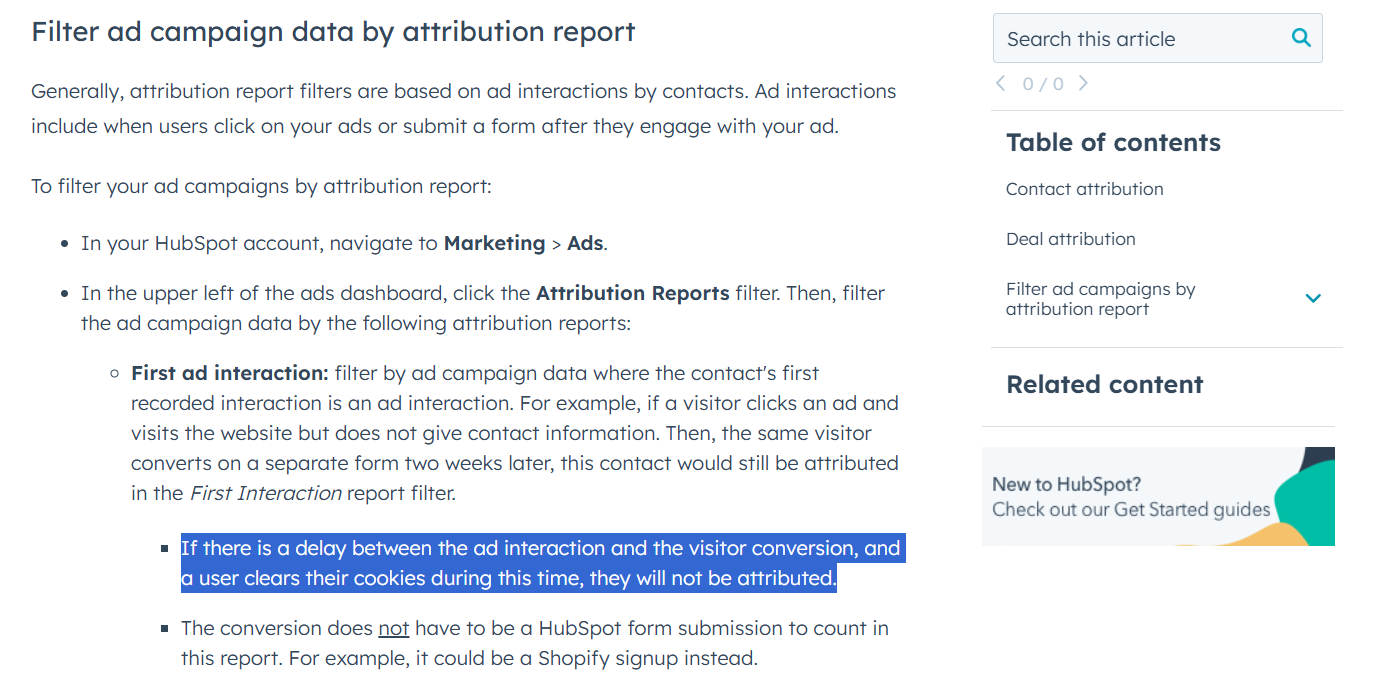
You’ll also miss influence signals from non-clickers. In B2B, it’s common for one team member to see the ad and another to submit the inquiry. Or for a committee to collectively view ads and develop interest, without ever clicking. Measuring LinkedIn ad impact means accounting for this type of multi-touch, cross-user influence.
- CRM tracking constraints: Platforms like HubSpot only log direct ad clicks that lead to immediate form submissions. The same goes for LinkedIn’s CAPI and Insight Tag.
- IP-based tools: In theory, they might surface non-clickers, but with ~40% accuracy and only for known sessions, the insight is shallow at best.
- LinkedIn Campaign Manager (Companies tab): Offers some impression-level data by company — but at the account-wide level. You still can’t tell which company engaged with which specific campaign or creative. That limits your ability to measure performance granularly.
How ZenABM Helps Measure the Impact of LinkedIn Ads Accurately
To evaluate LinkedIn ad effectiveness properly, you need a solution that captures account-level engagement, not just clicks, but also impressions, for every campaign and ad group. ZenABM does exactly that. By leveraging LinkedIn’s official APIs, it provides clean, campaign-specific data without relying on cookies, browser tracking, or IP matching.
This first-party setup reflects what’s *actually* happening with your ad spend. Here’s how ZenABM simplifies LinkedIn ad impact measurement:
Captures Every Company That Sees or Interacts with Your Ads

ZenABM’s dashboard lets you view detailed engagement by company for each LinkedIn campaign — including impressions, clicks, engagement actions, spend, and even CRM-matched deal values.
- Tracks impressions (even without clicks or conversions).
- Logs reactions like likes, comments, and shares.
- Captures click-throughs.
- Detects ad views without click interactions.
This means you can track influence even when there’s no direct conversion. For example, if Company X viewed your ads dozens of times but never clicked, then eventually requested a demo, ZenABM links those early impressions to the final outcome.
You’ll also see how multiple campaigns shaped the journey. Instead of guessing, ZenABM gives you a clear view-through attribution across your LinkedIn strategy.
Ensures Fair Attribution Across Campaigns
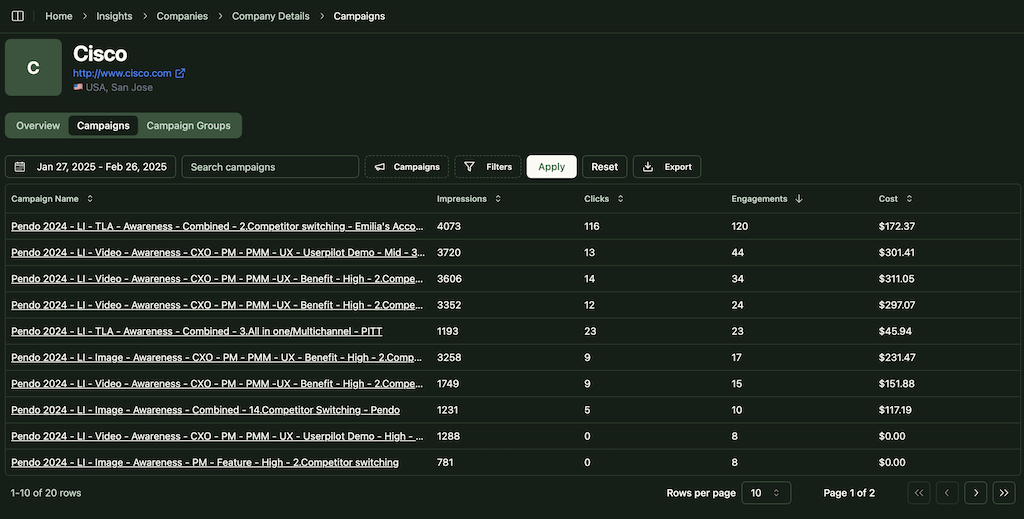
ZenABM reveals all LinkedIn campaigns that a company engaged with throughout their journey, helping you distribute credit accurately. Instead of favoring the last-touch or most-clicked campaign, you get a balanced picture of contribution.
Let’s say a buyer first engaged with a brand awareness ad, later clicked a product demo ad, and finally responded to a conversion-focused one. ZenABM ensures that all those touchpoints get recognized, not just the final one.
Pushes Engagement Insights to HubSpot Automatically
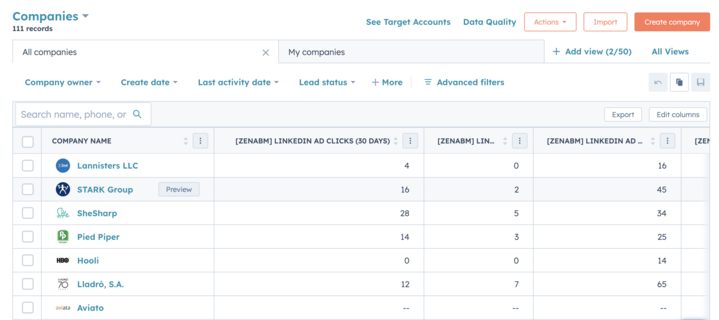
Forget the manual exports. ZenABM automatically updates your CRM with fresh LinkedIn ad data for each account. You’ll get fields like “Impressions – Last 7 Days” and “Clicks – Last 7 Days” pushed into HubSpot, enabling smarter segmentation, reporting, and automation.
Supports Automated Scoring, and BDR Routing

ZenABM includes real-time lead scoring based on ad engagement. Each account is given a score factoring in how often they saw or interacted with your ads — a strong proxy for buyer readiness. Once an account crosses a custom threshold, ZenABM can trigger automated actions, like routing the lead to a BDR:

Surfaces Buyer Intent by Campaign Topic
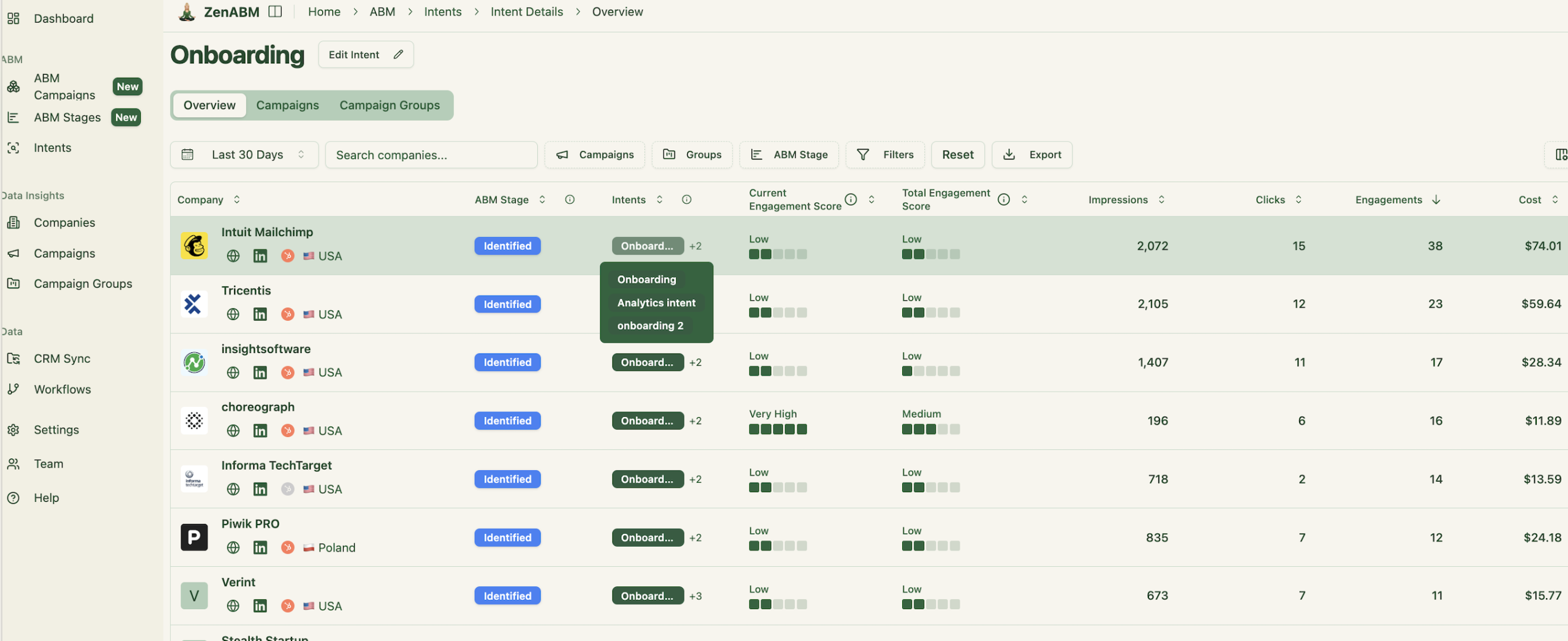
Each campaign or group in ZenABM can be tagged with the underlying intent — like feature focus or use case. As companies engage, ZenABM clusters them by interest. Your BDRs instantly know what themes resonate with which accounts.
Connects Ad Engagement to Pipeline and Revenue

Ultimately, measuring ad impact comes down to connecting efforts to outcomes. ZenABM bridges the gap — showing how engagement from LinkedIn ads ties back to pipeline activity and closed deals. You’ll know which campaigns contributed to actual revenue, not just clicks.
Includes Plug-and-Play Dashboards for ABM

ZenABM ships with ready-to-use dashboards tailored for ABM teams. No need for custom report building. You’ll get visuals that focus on what matters — from impressions and engagement to ROI, pipeline influenced, and account-level trends. It’s a shift from surface-level metrics to actionable, account-focused insights.
Built on Secure, First-Party Data — No Scraping
Lastly, ZenABM’s data approach is fully compliant with LinkedIn’s standards. With increasing crackdowns on unauthorized scraping:
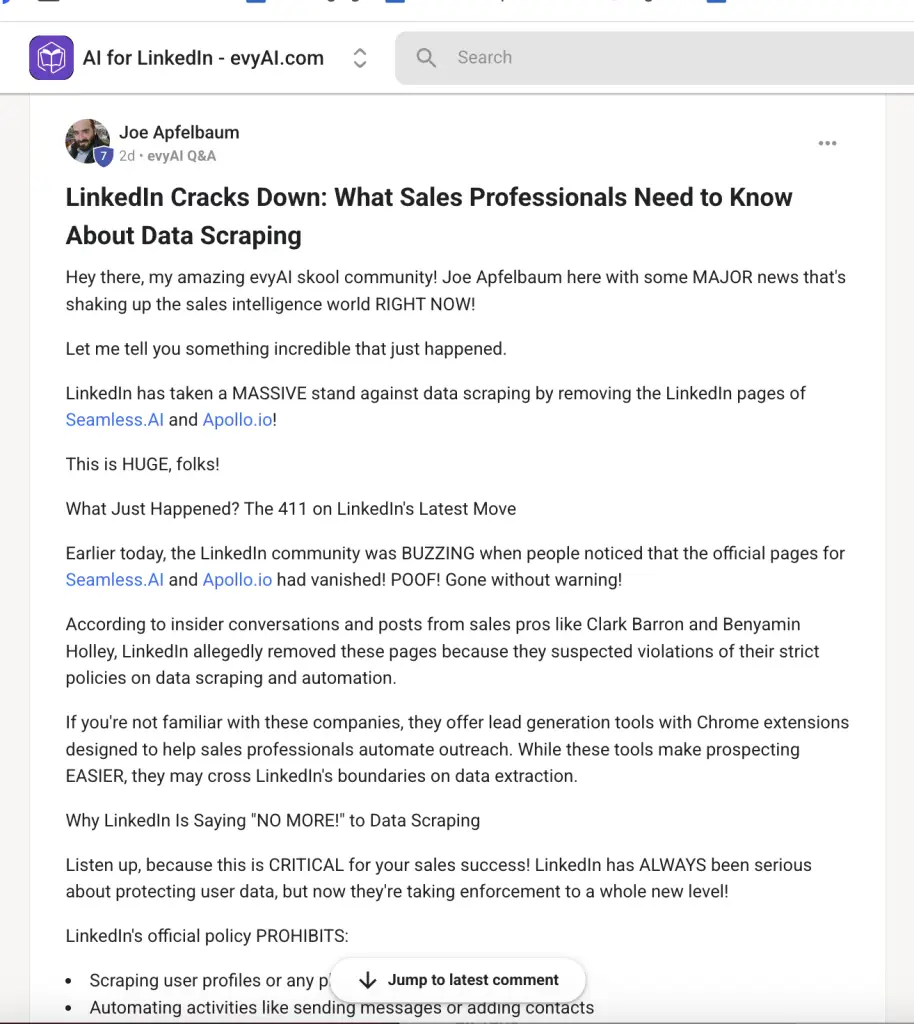
ZenABM keeps you safe. It uses only LinkedIn’s sanctioned API, offering real-time, compliant, first-party data directly from the platform itself. No gray areas. Just solid, reliable insights.
Over to You
Measuring the impact of LinkedIn ads goes far beyond tracking clicks or counting form submissions — it’s about capturing the entire buyer journey, from first exposure to final conversion. In B2B, where decisions involve multiple stakeholders and long cycles, basic attribution models like last-click just don’t cut it. They miss the earlier impressions and interactions that helped shape the outcome.
By embracing account-level measurement, you gain visibility into the unseen touchpoints that actually drive results. ZenABM empowers this shift with the tools and data to reveal which campaigns spark real engagement, shape brand perception, and contribute to revenue inside your key accounts. When you can see which ads truly influence the pipeline, not just which ones get clicked, you can double down on what genuinely delivers.
Want to leave guesswork behind and measure LinkedIn ad impact with confidence? Try ZenABM today and get the visibility you’ve been missing.

